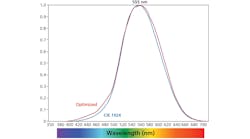Dow Corning has decades of experience in developing silicone materials, which are increasingly in demand as encapsulants and lenses for high-intensity LED packages.
As well as LEDs, the Light Management group will also be focusing on fiber-optics and optical assemblies, as well as light pipes and diffusion sheets. These disperse light evenly over the back of a display and could be used in conjunction with LEDs to make backlighting units.
Jeroen Bloemhard, Dow Corning's global marketing director for Electronics, explained to LEDs Magazine that the company's interest in LEDs began when high-brightness LEDs started to emerge.
"Initially, these devices were protected with an epoxy-type material," he says. "With higher-brightness devices, which operate at higher temperatures, these materials started to degrade and 'yellow' over time. Obviously, this influences the intensity of the light."
Silicones are very optically transparent and are also resistant against high temperatures, so they remain stable over time.
"The second area where silicones are starting to be applied is in manufacturing lenses," says Bloemhard. "They offer similar advantages – transparency, temperature resistance – but also moldability." The vast experience in injection molding of silicone materials is now being applied to LEDs to create the primary optics found in many packages.
LEDs with silicone lenses are just starting as production items, says Bloemhard, while silicone encapsulants are already widely used in high-power LEDs.
While there is little reason to switch to silicone for manufacturers of lower-brightness products, at the upper end of the scale the durability, extended lifetime and level of brightness than can be achieved using silicone provides a strong incentive.
Although many companies supply silicone, few are focusing on the LED market. "It does require a high level of technical understanding to be able to change the refractive index of the materials," says Bloemhard. The main competitors for Dow Corning in this field are the Japanese company Shin-Etsu and US-based NuSil.
High-brightness LEDs are already used in niche lighting applications, displays, automotive applications and handsets. "We expect that, over time, these types of LEDs will be used in general lighting applications," says Bloemhard. "This is clearly the point at which the market becomes really attractive for us."




